PRB Coal Users’ Group Educates Industry on the Dangers of Combustible Dust
The 2009 Powder River Basin Users’ Group (PRBCUG) hosted more than 340 registered members for the three-and-a-half-day 2009 Annual Meeting; 165 attendees were from operating companies. The meeting’s Grand Sponsor was Benetech’s Plant Professionals Group (Figure 1). Next year will be the 10th anniversary meeting of the PRBCUG, so starting making your plans to attend today (see sidebar).
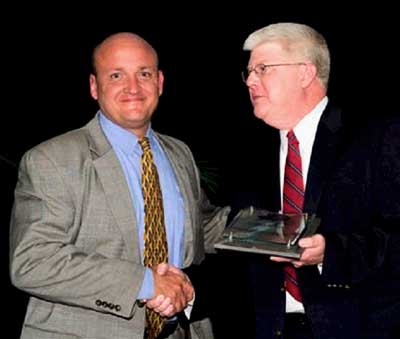
1. Ron Pircon, president and CEO of Benetech, receives the Grand Sponsor Appreciation Award from Bob Taylor, PRBCUG chairman. Source: COAL POWER
The meeting kicked off with the Power Plant Awards Banquet on Monday night, prior to the official start of the ELECTRIC POWER Conference (EP) the following morning. The evening’s festivities began with the announcement of the PRBCUG’s Plant of the Year award in the large plant category, which went to American Electric Power’s Rockport Plant. Next, the group’s Plant of the Year award in the small plant category went to Ameren’s Hutsonville Plant. The featured speaker of the night was Dave Dravecky, Major League Baseball pitcher, speaker, author, and cancer survivor.
PRBCUG Chairman Bob Taylor noted that “The PRB Coal Users’ Group Plant of the Year awards are about great people, dynamic leaders, working in harmony, doing good work on continual improvement. It’s not about perfection; it’s about getting better and doing it well.”
Recognizing AEP’s Rockport plant (Figure 2), Taylor praised the plant’s staff: “This plant, like many others that have brought PRB coal users together, wasn’t designed for PRB coal. A fatality from a dust explosion and numerous other experiences caused them to aggressively learn about the characteristics of PRB coals and implement actions for continuous improvements and proactive approaches to protecting people. Their journey wasn’t easy or without pain, and today we celebrate their achievement for their pursuit of protecting people and improvements.”

2. The PRB Coal Users’ Group’s 2009 Plant of the Year (Large Category) award was presented to American Electric Power’s Rockport Plant. Accepting the award from Bob Taylor, PRBCUG chairman, are (left to right) Jennifer Bracher, regional engineer; Pat Hale, plant manager; Mike Turner, materials handling process supervisor; Jim Ahl, coal equipment operator; and Dave Adkins, operations specialist. Source: COAL POWER
Next up on the stage was the staff of Ameren’s Hutsonville Plant (Figure 3). “This plant’s staff is from a smaller plant in size and one with a huge heart,” continued Taylor. “They are a story of family. Whenever faced with uncertainty—first by the need to be price competitive in the changing market and, more recently, the whole discussion of Where is our industry headed?—they responded with the cohesiveness of family and plowed forward, always taking care of each other, their families, and business. They share a remarkable story of how to improve and make changes and make it look simple.”
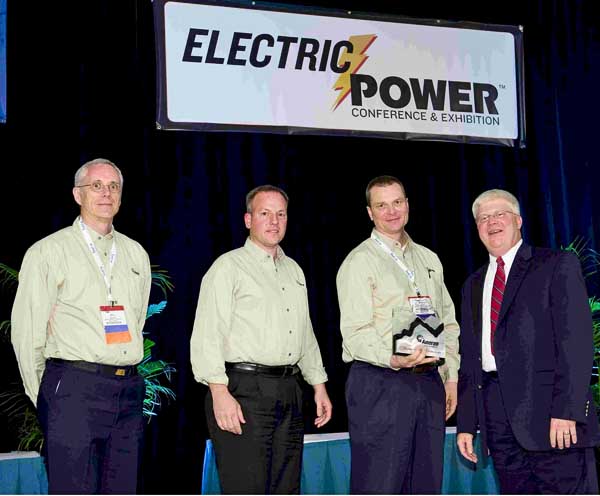
3. The PRB Coal Users’ Group’s 2009 Plant of the Year (Small Category) award was presented to Ameren’s Hutsonville Plant. Accepting the award from PRBCUG Chairman Bob Taylor are (from left to right) Mike Stewart, plant engineer; Jim Alberda, plant engineer; and Greg Musch, production superintendent. Source: COAL POWER
At the banquet the PRBCUG also recognized the six students from the University of Maryland, University of West Virginia, and South Dakota School of Mines and Technology that it sponsored during the past year.
The PRBCUG would like to thank all of the genco and industry sponsors for their continued support and participation in the group’s activities.
Inspiring Speaker
The featured speaker at the annual Industry Awards Banquet was Dave Dravecky, former professional baseball player, who lost his pitching arm to cancer (Figure 4).
Dravecky lived the American dream as a professional baseball pitcher and reached the pinnacle of his professional career by pitching in the National League Championships and the World Series for the San Diego Padres and, later, for the San Francisco Giants. At the height of his brilliant baseball career, Dravecky was diagnosed with cancer in his pitching arm. He underwent surgery to remove the tumor and his deltoid muscle. After intensive rehabilitation, he came back to pitched the Giants to a 4-3 win over Cincinnati—only to break his arm in a game five days later. The cancer had returned, which led to the amputation of his pitching arm. Dravecky, along with his wife Jan, wrote two books that explored his battle with cancer and the aftermath: Comeback and When You Can’t Come Back.
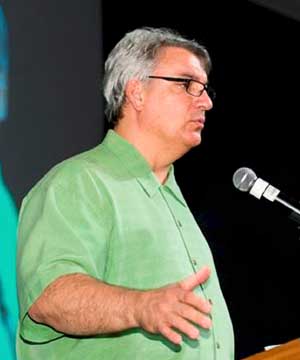
4. Dave Dravecky, former professional baseball star and cancer survivor, presented his story at the Industry Awards Banquet the evening before the ELECTRIC POWER and PRBCUG conferences began. Source: COAL POWER
Who We Are and What We Do
The PRBCUG is a nonprofit association of persons, firms, and corporations interested and engaged in the utilization of PRB coals (Figure 5). The PRBCUG does not lobby for increased usage of PRB coals. Rather, it was formed to promote the safe, efficient, and environmental use of PRB coals by electric generating companies that currently use, or are considering using, the coal. These goals are achieved by preparing best practices for the safe operation and maintenance of systems that use PRB coals and providing a forum for sharing those best practices and operating experiences.

5. A new Board of Directors was introduced at the PRB Coal Users’ Group Annual Meeting held in early May at the ELECTRIC POWER Conference. From left to right: Dave Johnson, executive director, TradeFair Group and PRBCUG treasurer; Joel Booher, principal engineer for boiler performance, Diamond Power International Inc.; Ed Douberly, president of the Utility FPE Group and PRBCUG secretary; Barry Boswell, director of generation, Luminant’s Martin Lake Power Plant; Randy Rahm, president of CoalTech Consultants and PRBCUG executive director; Mark Collett, vice president, Plant Professionals; Greg Krieser, plant manager, Omaha Public Power District’s North Omaha Station and incoming PRBCUG chairman; Don Pearson, manager of regional field engineering services for Babcock & Wilcox; John Bridson, executive director, Westar Energy’s Lawrence Energy Center; Dave Vendel, fuel handling supervisor, Lower Colorado River Authority’s Fayette County Power Plant; Jim Wiseman, president of Wiseman Consulting; and Robert Taylor, safety and protection leader for American Electric Power and outgoing PRBCUG chairman. Not pictured: Doug Hart, manager, firing systems engineering, Alstom; Charles Kitchens, project manager, Southern Company. Source: COAL POWER
Combustible Dust Is a Hot Topic
Chairman Bob Taylor, manager of environmental safety and health at American Electric Power, opened the 9th annual PRBCUG meeting with a review of the group’s past year’s accomplishments. This year, the hot topic for the power industry is combustible dust from all types of coals used in the power industry (Figure 6). The OSHA National Emphasis Program (NEP) does not differentiate between coals. The PRBCUG’s Combustible Dust webinar was a great success and is still available on demand and without charge. If the dust has a Kst value greater than 0, it is classified as a combustible dust. OSHA will be focusing on your combustible dust in the future with the addition of an estimated 1,200 new inspectors.

6. Mark Collett, vice president of Plant Professionals; Rob Holliday, safety team leader for Luminate; and Chris Blazek, vice president of Benetech look at a room full of interested members as they begin their session on the dangers of combustible dust. Source: COAL POWER
Jordan Barab joined OSHA as deputy assistant secretary of labor for occupational safety and health as well as acting assistant secretary on April 13, 2009. If you have any doubt that there are going to be dramatic changes in the way OSHA is going to approach health and safety in the workplace, go to Barab’s former weblog at http://spewingforth.blogspot.com/ and read his postings. His focus will be improving overall health and safety in the workplace, with an emphasis on confined space and combustible dust.
Barab is not a politician but an advocate for the health and safety of all workers. There is a new sheriff in town, and he is walking tall with a big stick, on a mission to clean up industries and make them a safer place for workers. The power industry should take note and clean up its plants or be ready to pay dearly in fines or lawsuits that are on the horizon. That being said, the penalties today are not inconsequential:
- Punishment for NEP via OSH Act of 1970, Section 5(a).
- Fines as high as $8.4 million, with many between $1 million and $2 million.
- As of January12, 2009, OSHA can issue per-employee citations for personal protective equipment.
- Under section 11(b) of the OSH Act, Department of Justice attorneys can, if necessary, obtain enforcement orders, and then seek to hold employers in contempt of those orders if the employers continue to fail to abate hazards or implement other provisions in citations, settlements, or orders of the Occupational Safety and Health Review Commission and federal courts. Potential sanctions for contempt include daily penalties and other fines, incarceration of an individual company officer who flouts the court’s order, as well as any other sanction that the court deems necessary to secure compliance. (Spoken during testimony of Jordan Barab on April 30, 2009.)
- Federal and state OSHA programs conduct approximately 90,000 inspections each year. Federal OSHA cited almost 89,000 violations in FY 2008. Over 80% of these violations were classified as willful, serious, or repeat.
Last year representatives from the railroads and coal mines talked about the record tonnage shipping out of the PRB. At that time utilities were already at record inventory levels. Today, inventory levels are beyond many of the utilities’ ability to properly manage their stockpiles. Utilities do not have the required real estate to properly compact their stockpiles. These stockpiles had spontaneous combustion issues leading to a number of conveyor and silo fires this year.
Utilities must manage their silos/bunkers by lowering their levels weekly to ensure that all stagnant coal has been removed. There should be an increase in scheduled housekeeping to remove any coal and dust buildup on or around equipment.
Fires are continuing to occur at an alarming rate. Please protect your employees and your shareholders’ assets by being proactive in your coal yards.
PRBCUG Publishes Electrical Best Practice
The Electrical Best Practice was completed and is now posted on the PRBCUG’s website for members. A special thanks to Bill Rezek, lead electrical engineer for Shaw Power, for making it happen. (The PRBCUG Board of Directors established two new subcommittees: Fire Protection System and Coal Blending and Quality Assurance. These subcommittees are charged to have their best practices complete for next year’s meeting in Baltimore.)
Bill Rezek, Electrical Best Practice subcommittee cochair, began his presentation on the new electrical standard by clarifying the practice’s support codes and standards and offers (with reference to applicable codes) methodology, which demonstrates an inclusive approach to operations and maintenance safety while attempting to minimize capital expenditures and ensuring code compliance.
Mark Collet served as the other subcommittee cochair. He noted that, when effectively applied, the best practice will reduce the risk and likelihood of PRB coal ignition from combustion sources or spontaneous combustion due to electrical system component failures, maintenance practices, or facility operating methods.
It must be noted that this document is not meant to be the sole document for code and standards interpretation. Nor is it meant to be a “synopsis” of the codes and their interpretations. It will assist users in finding the information necessary to address the codes and the potential impact those codes and standards may have when properly (or improperly) applied.
The Electrical System Guidelines is the most detailed document developed to date by members of the PRBCUG. All of those who participated should be commended for the time and effort they devoted to the guidelines’ development.
Honoring Leadership
The PRBCUG Board of Directors would like to thank Bob Taylor, past chairman, for his outstanding service to the group over the past two years (Figure 7). Bob has guided the group to new heights in attendance, webinars, student sponsorships, and an updated website. Bob is motivated in life and in his work to make sure each and every employee returns home safely.
We would also like to welcome the incoming chairman, Greg Krieser, and wish him a successful two-year term (Figure 8).
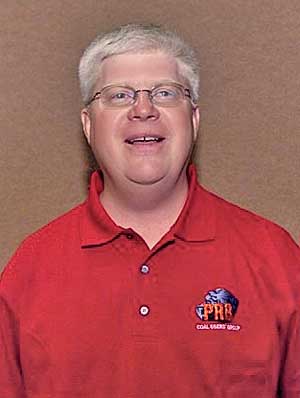
7. PRBCUG past Chairman Bob Taylor. Source: COAL POWER
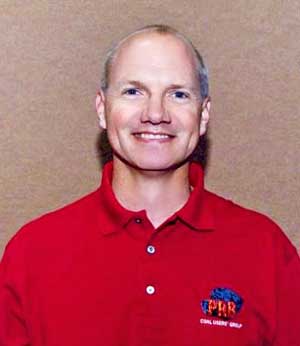
8. Incoming PRBCUG Chairman Greg Krieser. Source: COAL POWER
—Randy Rahm ([email protected]) is president of CoalTech Consultants Inc., former chairman of the PRBCUG, and a POWER contributing editor.